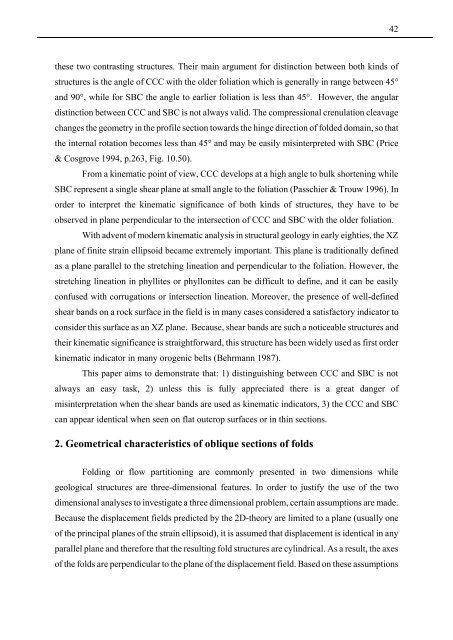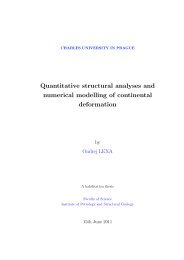PhD. thesis - Univerzita Karlova
PhD. thesis - Univerzita Karlova
PhD. thesis - Univerzita Karlova
Create successful ePaper yourself
Turn your PDF publications into a flip-book with our unique Google optimized e-Paper software.
these two contrasting structures. Their main argument for distinction between both kinds of<br />
structures is the angle of CCC with the older foliation which is generally in range between 45°<br />
and 90°, while for SBC the angle to earlier foliation is less than 45°. However, the angular<br />
distinction between CCC and SBC is not always valid. The compressional crenulation cleavage<br />
changes the geometry in the profile section towards the hinge direction of folded domain, so that<br />
the internal rotation becomes less than 45° and may be easily misinterpreted with SBC (Price<br />
& Cosgrove 1994, p.263, Fig. 10.50).<br />
From a kinematic point of view, CCC develops at a high angle to bulk shortening while<br />
SBC represent a single shear plane at small angle to the foliation (Passchier & Trouw 1996). In<br />
order to interpret the kinematic significance of both kinds of structures, they have to be<br />
observed in plane perpendicular to the intersection of CCC and SBC with the older foliation.<br />
With advent of modern kinematic analysis in structural geology in early eighties, the XZ<br />
plane of finite strain ellipsoid became extremely important. This plane is traditionally defined<br />
as a plane parallel to the stretching lineation and perpendicular to the foliation. However, the<br />
stretching lineation in phyllites or phyllonites can be difficult to define, and it can be easily<br />
confused with corrugations or intersection lineation. Moreover, the presence of well-defined<br />
shear bands on a rock surface in the field is in many cases considered a satisfactory indicator to<br />
consider this surface as an XZ plane. Because, shear bands are such a noticeable structures and<br />
their kinematic significance is straightforward, this structure has been widely used as first order<br />
kinematic indicator in many orogenic belts (Behrmann 1987).<br />
This paper aims to demonstrate that: 1) distinguishing between CCC and SBC is not<br />
always an easy task, 2) unless this is fully appreciated there is a great danger of<br />
misinterpretation when the shear bands are used as kinematic indicators, 3) the CCC and SBC<br />
can appear identical when seen on flat outcrop surfaces or in thin sections.<br />
2. Geometrical characteristics of oblique sections of folds<br />
Folding or flow partitioning are commonly presented in two dimensions while<br />
geological structures are three-dimensional features. In order to justify the use of the two<br />
dimensional analyses to investigate a three dimensional problem, certain assumptions are made.<br />
Because the displacement fields predicted by the 2D-theory are limited to a plane (usually one<br />
of the principal planes of the strain ellipsoid), it is assumed that displacement is identical in any<br />
parallel plane and therefore that the resulting fold structures are cylindrical. As a result, the axes<br />
of the folds are perpendicular to the plane of the displacement field. Based on these assumptions<br />
42







